Just like people, pets often have problems with gum disease and plaque and tartar build-up on their teeth. In fact, by three years of age a majority of dogs and cats will have mild-to-moderate dental disease that would benefit from a comprehensive oral examination and treatment performed under general anesthesia. Left untreated, dental disease can lead to more serious health complications, some of which may extend far beyond your pet’s teeth. For many reasons, it truly is important to include dental care as part of your pet’s overall preventive health care program.
The benefits of routine dental hygiene include reduced bad breath, better overall health, decreased pain, increased longevity, and reduced pet health care bills down the road.
General anesthesia is an important part of the veterinary dentist’s toolkit, and it need not be a scary process – for you or your pet. For several very good reasons, the American Veterinary Dental College recommends that pets undergo general anesthesia for dental cleanings as well as for more involved procedures. These reasons include:
Safety of both the patient and hygienist
Reduced pain and stress for the patient
Ability to perform a complete oral examination
Ability to perform a professional cleaning of all tooth surfaces, including areas below the gum line
Ability to polish and smooth out any microabrasions caused by the scaling process
Ability to perform radiographs (x-rays) of the teeth to detect damage and infection
Prevention of aspiration (inhalation) by protecting the pet’s airway (windpipe) with an endotracheal tube
Pet Dental Health Tips:
By three years of age a majority of dogs and cats will have mild-to-moderate dental disease that would benefit from a comprehensive oral examination and treatment performed under general anesthesia.
Anesthesia-free dentistry is becoming more popular and is often touted as a ‘safer alternative’ to anesthetized dentals, but it is important to be aware that such practices can compromise the health and safety of your pet.
Anesthesia-free dentistry may remove visible tartar and leave teeth looking clean, but gum and tooth disease could still be present.
Anesthesia-free dentistry is an example of when dental scaling is performed on animals that are awake. Though this practice is becoming more popular and is often touted as a ‘safer alternative’ to anesthetized dentals, it is important for you, as your pet’s advocate, to be aware that such practices can compromise the health and safety of your pet. Here are a few of the many reasons why anesthesia-free dentistry is not recommended:
When your pet is alert and awake, dental procedures often increase stress and cause pain.
If your pet moves during the cleaning procedure, there is potential for the sharp scaling tools to injure your pet’s mouth.
Because your pet is awake, the operator is unable to perform a thorough examination of the mouth, including the important evaluation of the ligaments and bone below the gum line. This means that significant disease often goes undetected and untreated.
Similarly, when your pet is conscious, it is not possible to thoroughly clean all surfaces of the teeth, including the surfaces below the gum line where most problems exist.
When your pet is not anesthetized using an endotracheal tube, there is risk of tartar, water, cleaning material and debris going into your pet’s lungs.
Anesthesia-free dentistry may remove visible tartar and leave teeth looking clean. However, gum and tooth disease and sources of pain that are not visible or easily accessible in an awake pet cannot be effectively addressed with such non-anesthetized procedures.
Unlike you and me, who can obey our dentist’s instructions to open our mouths and turn our heads this way and that, your pets are not likely to cooperate enough to allow for a safe or thorough examination and cleaning if they are awake. And consider this, if your pet won’t sit still for you to brush their teeth, how do you think they are going to react to a stranger trying to scrape their teeth with sharp instruments?
